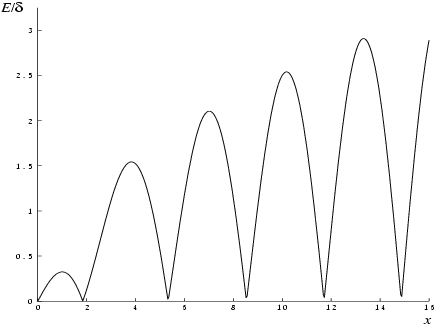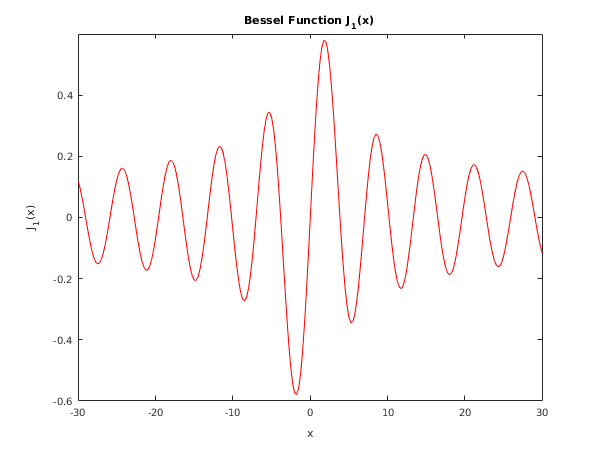PDF version (NAG web site
, 64-bit version, 64-bit version)
NAG Toolbox: nag_specfun_bessel_j1_real (s17af)
Purpose
nag_specfun_bessel_j1_real (s17af) returns the value of the Bessel function , via the function name.
Syntax
Description
nag_specfun_bessel_j1_real (s17af) evaluates an approximation to the Bessel function of the first kind .
Note: , so the approximation need only consider .
The function is based on three Chebyshev expansions:
For
,
For
,
where
,
and ,
with .
For
near zero,
. This approximation is used when
is sufficiently small for the result to be correct to
machine precision.
For very large
, it becomes impossible to provide results with any reasonable accuracy (see
Accuracy), hence the function fails. Such arguments contain insufficient information to determine the phase of oscillation of
; only the amplitude,
, can be determined and this is returned on soft failure. The range for which this occurs is roughly related to
machine precision; the function will fail if
.
References
Abramowitz M and Stegun I A (1972) Handbook of Mathematical Functions (3rd Edition) Dover Publications
Clenshaw C W (1962) Chebyshev Series for Mathematical Functions Mathematical tables HMSO
Parameters
Compulsory Input Parameters
- 1:
– double scalar
-
The argument of the function.
Optional Input Parameters
None.
Output Parameters
- 1:
– double scalar
The result of the function.
- 2:
– int64int32nag_int scalar
unless the function detects an error (see
Error Indicators and Warnings).
Error Indicators and Warnings
Errors or warnings detected by the function:
-
-
x is too large. On soft failure the function returns the amplitude of the
oscillation,
.
-
An unexpected error has been triggered by this routine. Please
contact
NAG.
-
Your licence key may have expired or may not have been installed correctly.
-
Dynamic memory allocation failed.
Accuracy
Let be the relative error in the argument and be the absolute error in the result. (Since oscillates about zero, absolute error and not relative error is significant.)
If
is somewhat larger than
machine precision (e.g., if
is due to data errors etc.), then
and
are approximately related by:
(provided
is also within machine bounds).
Figure 1 displays the behaviour of the amplification factor
.
However, if
is of the same order as
machine precision, then rounding errors could make
slightly larger than the above relation predicts.
For very large
, the above relation ceases to apply. In this region,
. The amplitude
can be calculated with reasonable accuracy for all
, but
cannot. If
is written as
where
is an integer and
, then
is determined by
only. If
,
cannot be determined with any accuracy at all. Thus if
is greater than, or of the order of, the reciprocal of
machine precision, it is impossible to calculate the phase of
and the function must fail.
Further Comments
None.
Example
This example reads values of the argument from a file, evaluates the function at each value of and prints the results.
Open in the MATLAB editor:
s17af_example
function s17af_example
fprintf('s17af example results\n\n');
x = [0 0.5 1 3 6 8 10 -1 1000];
n = size(x,2);
result = x;
for j=1:n
[result(j), ifail] = s17af(x(j));
end
disp(' x J_1(x)');
fprintf('%12.3e%12.3e\n',[x; result]);
s17af_plot;
function s17af_plot
x = [-30:0.25:30];
for j = 1:numel(x)
[J1(j), ifail] = s17af(x(j));
end
fig1 = figure;
plot(x,J1,'-r');
xlabel('x');
ylabel('J_1(x)');
title('Bessel Function J_1(x)');
axis([-30 30 -0.6 0.6]);
s17af example results
x J_1(x)
0.000e+00 0.000e+00
5.000e-01 2.423e-01
1.000e+00 4.401e-01
3.000e+00 3.391e-01
6.000e+00 -2.767e-01
8.000e+00 2.346e-01
1.000e+01 4.347e-02
-1.000e+00 -4.401e-01
1.000e+03 4.728e-03
PDF version (NAG web site
, 64-bit version, 64-bit version)
© The Numerical Algorithms Group Ltd, Oxford, UK. 2009–2015

